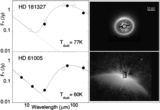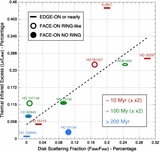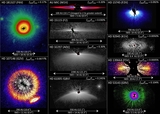Image Details

Caption: Figure 12.
Mid-plane of the asymmetrically extended HD 15115 CS debris disk, found from fitting the locus of points defining the peak SB across the apparent disk major axis at r > 1![]() 5 on both sides of the star, is overplotted on the disk image. The morphology and deviation of the flux density excess at smaller stellocentric distances is to the north of the star only. This qualitatively suggests a nearly edge-on inner debris ring (schematically represented in the image inset), reminiscent of HD 61005 (see Section A.6) that may be only partially cleared in the interior. The western side of the posited ring in this image, "above" the plane of the disk, is more readily seen (compare to the illustration inset). The eastern side of the debris ring may be distorted (or partially obscured) by more complex disk features, e.g., as evidenced by the bifurcated structure highlighted in Figure 11(C), arising from extrinsic forces noted in the main text. This image north up, east left with a log10 display stretch from [−3.5] to [+1.0] counts s−1 pixel−1 {dex} (0.056 to 3532 μJy arcsec−2) and 25
5 on both sides of the star, is overplotted on the disk image. The morphology and deviation of the flux density excess at smaller stellocentric distances is to the north of the star only. This qualitatively suggests a nearly edge-on inner debris ring (schematically represented in the image inset), reminiscent of HD 61005 (see Section A.6) that may be only partially cleared in the interior. The western side of the posited ring in this image, "above" the plane of the disk, is more readily seen (compare to the illustration inset). The eastern side of the debris ring may be distorted (or partially obscured) by more complex disk features, e.g., as evidenced by the bifurcated structure highlighted in Figure 11(C), arising from extrinsic forces noted in the main text. This image north up, east left with a log10 display stretch from [−3.5] to [+1.0] counts s−1 pixel−1 {dex} (0.056 to 3532 μJy arcsec−2) and 25![]() 4 × 10
4 × 10![]() 4 FOV.
4 FOV.
Copyright and Terms & Conditions
© 2014. The American Astronomical Society. All rights reserved.












